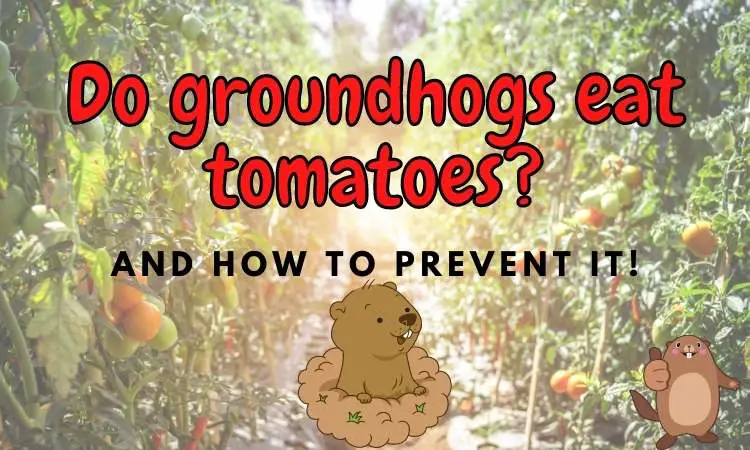This is a question that many yard owners want to know the answer to. The short answer is yes, groundhogs do eat tomatoes. However, they also eat other fruits and vegetables, as well as insects.
However, groundhogs are generally herbivores, which means that they mostly eat plants.
In short, groundhogs will eat tomatoes, even unripe ones if available. They do, however, not eat the tomato plant parts as it belongs to the nightshade family toxic to groundhogs. If you are having trouble with groundhogs in your tomatoes, I will also teach you how to keep them away from your yard!
Tomatoes are a fruit and the groundhog, also known as a woodchuck, is not picky when it comes to fruits and vegetables.
Groundhogs will eat and drink from your tomato plants, but they do not typically eat them entirely. They like to use them as a way of getting water and nutrients in one go which makes it easier for them to survive.
Do groundhogs only eat ripe tomatoes?
Ripe tomatoes are not too sweet for groundhogs and they contain more energy, so they usually eat ripe tomatoes if they can get hold of them. However, they will also eat unripe tomatoes if they are available.
In the video below, a cheeky groundhog eats all kinds of garden vegetables, including green and red tomatoes!
Groundhogs are generally not very picky when it comes to their food and will eat whatever is available to them. And many backyard vegetables like onions, zucchini, squash but also fruits and flowers are on their menu!
Why do Groundhogs Like Tomatoes?
Groundhogs love eating tomatoes because they are a perfect mix of water and fruit. Groundhogs will drink the natural water content from your tomato plants to survive as well as eat the fleshy part of the fruit for their dietary purposes.
Groundhogs eat almost any plant that we would eat and if you have other plants in your garden or yard, make sure to keep them out of reach of the groundhog as well.

Groundhogs will not likely go out of their way to eat your vegetables, but if it is in the area they are foraging in then there is a good chance that they will try to eat it.
What other animals could have eaten my tomatoes?
Groundhogs aren’t the only animals that like to eat tomatoes in your backyard. Other common ones in North America include raccoons, deer, gophers, rats, opossums, skunks, squirrels, and bears.
But groundhogs in particular are especially fond of eating tomato plants because they offer a balance of easily accessible water and nutrients in one place.
Some backyard birds may also love eating tomatoes, but they tend to inflict less damage due to their smaller sizes.
Also, they are typically not bold enough to come close to your plants since there is a high chance that you will scare them away with your presence during the day, whereas groundhogs will mostly forage during the early mornings and evenings when you are not around.
Finally, other rodents like rats or gophers are also attracted to a yard with vegetables and will not hesitate to eat the nice and juicy tomatoes you have spent so much time growing.
Gophers will not only eat them above ground but will also eat tomato plants by the roots from their tunnels underneath!
And yes – groundhogs and gophers can stay underground for weeks or months, especially during winter, so you will have to be ready when they come out in spring!
How do I protect my tomato plants from groundhogs?
There are several ways to protect your tomato plants against groundhogs, including using onion bags around the plant, deer repellent, fencing, ultrasonic sound, and light-reflecting objects.
Scarecrows may also be effective long-term solutions for keeping groundhogs away from your tomato plants.
If you experience groundhogs, or other animals, eating your tomatoes, here are several ways to protect your tomato plants from predation:
1. Motion-activated sprinklers
Like most animals, groundhogs hate surprises, and they will run away if suddenly sprayed with water. I like this solution because it is humane, simple, effective, and does not require much time to set up.
The Havahart 5277 is a motion-activated sprinkler that is activated by the movement of animals up to 25 feet away and sprays them with a harmless water jet, frightening them off and keeping them at bay. The included metal stake makes it easy to install in your garden, and the sprinkler can be rotated 180 degrees for maximum coverage.
2. Ultrasonic sound emitters
Groundhogs, like other bigger animals that may invade your garden, tend to have a very good hearing. This means that loud or consistent noises will scare them away or at least shorten their visits without harming them at all.
One of my favorite technologies to keep groundhogs away from my backyard is these cool solar-powered ultrasonic sound emitters that you can buy right off Amazon! In my experience, they really work, and the solar panels on top save you the time and money of changing batteries all the time.
3. Use Deer Repellent
Deer repellents are a great way to keep your tomato plants safe from any type of herbivore, including groundhogs. Some good ways to take advantage of this method is to use sprays or granules that you can spread around the area.
However, you should also pay attention to the ingredients that are present in the deer repellent and be sure to avoid the most toxic ones near your food and vegetables.
4. Fencing
Using fencing is a very effective way to keep groundhogs away from your tomato plants. You will need to make sure that the fencing is at least 2 feet in height and has small openings, such as 1 inch or less (2.54 cm). Most chicken fencing types will do. This will be strong enough to stop them from getting through while still allowing for airflow and sunlight.
5. Lighting
Groundhogs do not like light, so a great way to deter them from your tomato plants is by using lighting around the area. These come in many forms with solar panels etc. but you can use anything that will provide strong light over a large area, such as lanterns.
6. Scarecrow
Scarecrows are another great way to keep groundhogs away from your tomato plants. You can put them in many different places for maximum effectiveness. The scarecrow should be able to move around so that it will startle the groundhog if it gets too close to your plants.
7. Use Onion Bags Around Your Tomato Plants
Onion bags are a great way to stop groundhogs from getting to your plants. A good trick is to pick up some onion bags and put them over the top of your tomato plants for protection. This will help keep the groundhog from having access to them as they act as strong repellents.
8. Using Light and Reflectors
Groundhogs are nocturnal animals so they may avoid areas that have bright lights. Motion-activated lights, sounds, and sprinklers may help prevent groundhogs from entering your yard.
Another option is to use reflective materials.
Compact discs (CDs) are a great way to keep groundhogs away from your tomato plants.
They act as reflective surfaces that scatter light all over. And also, when the groundhog approaches, it will see its reflection and leave the area. This is because groundhogs are quite stupid, and they think there is another animal in the area with them.
9. Using live traps
Using live traps to catch the groundhog and drive it away to somewhere safe, but far away, is perhaps the best option if you want to get completely rid of groundhogs in your yard!
You can make a trap yourself with some wire and ingenuity…
Or, you can also just buy a live trap, as the sturdy metal ones shown here:
Put in some bait (a tomato?!) and you are ready to catch some groundhogs!
In conclusion
While traps may be dangerous to pets or children if not properly monitored and repellants can be expensive, toxic, and take time to work. Fences are a good option if you have the space, but they may not be practical in all situations.
Scare tactics such as making loud ultrasounds or using reflectors and scarecrows are probably more effective long-term solutions in my view.











